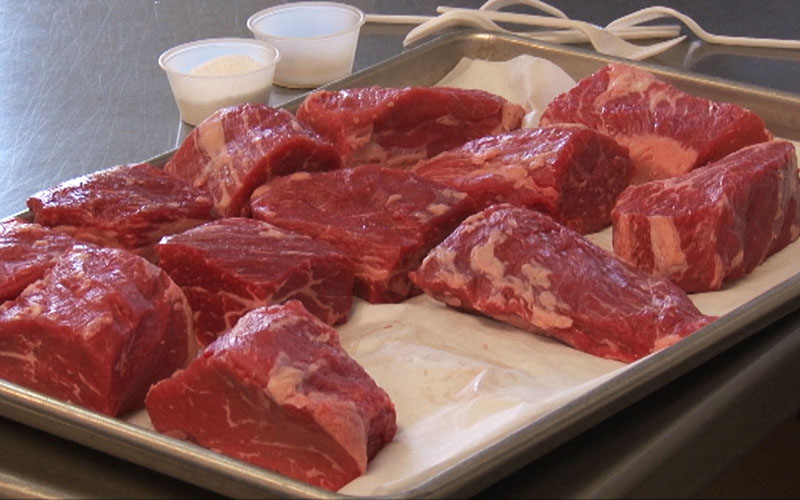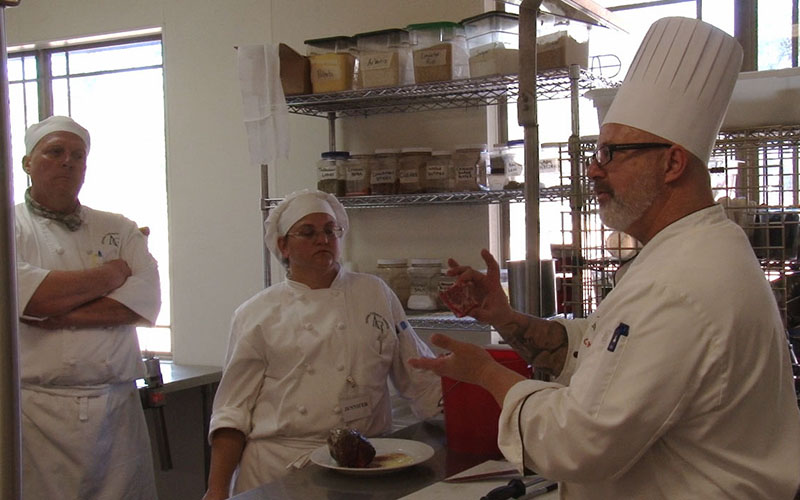
Three chefs prepare salads during their training at the Arizona Culinary Institute in Scottsdale, Arizona. (Photo by Blake Benard/Cronkite News)

Meat sits before being properly bagged at the Arizona Culinary Insitute in Scottsdale, Arizona. (Photo by Blake Benard/Cronkite News)

One lead chef instructs others on how to proper prepare and bag meat for later use at the Arizona Culinary Institute in Scottsdale, Arizona. (Photo by Blake Benard/Cronkite News)

Executive Chef at the Arizona Culinary Institute talks about food safey.
(Photo by Blake Benard/Cronkite News)
Chefs and health inspectors approach dining out in different ways but share a common goal: to reward your trust in restaurants by making sure food is safe for you to eat.
Tips:
- Observe your server’s behavior. “When I’m dining at a restaurant, I mean I’m walking in, I’m looking at a table. I’m watching my server. Are they touching my silverware in a way they shouldn’t be. How are they holding the glass when they deliver it to me?” Wolf said. “When they walk away from the table, are they scratching their face or sneezing then touching the plate that they serve food on?”
- Speak up. If you see a potential safety violation or eat food that doesn’t seem right, say so. “Don’t be afraid to be that customer,” Wolf said.
It’s a serious issue. Recently, Chipotle, the national restaurant chain, dealt with an E. Coli outbreak that affected 55 people and hospitalized 21. In 2013, an E. coli oubreak at a Mexican food restaurant in the southwest Valley sickened 94 people and led to the temporary closure of the restaurant.
Chefs and others who work in kitchens follow strict guidelines while preparing food to ensure it remains safe, Wolf said.
“You’re talking about times and temperatures and dealing with potentially hazardous foods. Cross contamination is a huge one. Making sure things are stored properly,” Wolf said.
He emphasizes to students to avoid cross contamination by cleaning their hands and kitchen tools like cutting boards after they touch raw chicken, meat or fish and before moving on to the next task.
Maricopa County health inspectors also make regular visits to restaurants to make sure they are following proper food safety rules. It’s a health code checklist of 53 points, from food temperature to employee sanitation, said Alicia Coonen, a county health inspector.
Restaurants can get bad grades from inspectors and if they get too many violations run the risk of being shut down. Maricopa County has an app that will help find any restaurant’s latest health inspection and inspection information also is on their website.
However, restaurants can decide whether or not to receive a grade based on their inspection.
“People always ask me when they find out I’m a health inspector, they say where should I eat, where should I not eat,” Coonen said. “I tell them the first thing they can do is pull up their smartphone, download our app.”